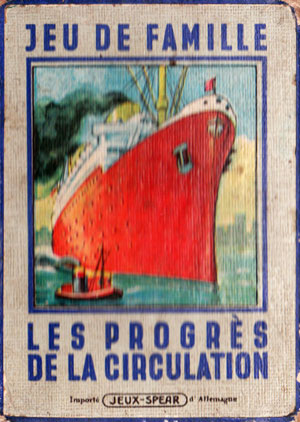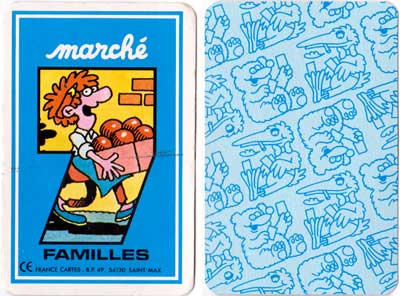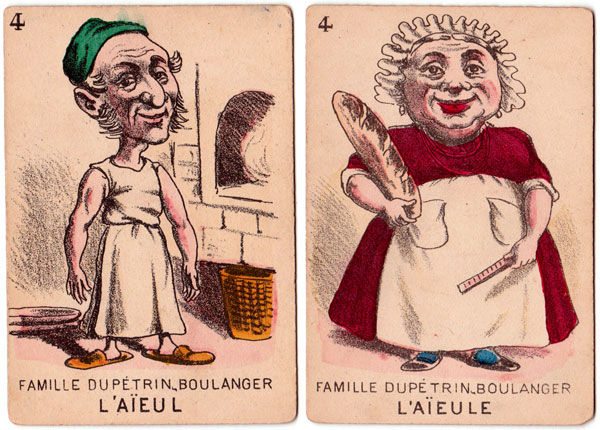Le Progrès de la Circulation
The beautiful images in this quartet game published by Jeux Spear in 1933 depict the progress of transport and travel since early times up til the 1930s.
Jeu de Famille “Le Progrès de la Circulation” - 1933

The beautiful images in this quartet game published by Jeux Spear for the French market in 1933 depict the progress of transport and travel since early times (Viking ships, canoe, hot air balloon, etc) up til the 1930s. Each set of four cards has a ‘suit symbol’ at the upper left corner representing the mode of transport, and a brief history of each mode of travel is given at the bottom of each card. 40 cards in box. The cards were manufactured in Germany.
See also:

By Rex Pitts (1940-2021)
Member since January 30, 2009
Rex's main interest was in card games, because, he said, they were cheap and easy to get hold of in his early days of collecting. He is well known for his extensive knowledge of Pepys games and his book is on the bookshelves of many.
His other interest was non-standard playing cards. He also had collections of sheet music, music CDs, models of London buses, London Transport timetables and maps and other objects that intrigued him.
Rex had a chequered career at school. He was expelled twice, on one occasion for smoking! Despite this he trained as a radio engineer and worked for the BBC in the World Service.
Later he moved into sales and worked for a firm that made all kinds of packaging, a job he enjoyed until his retirement. He became an expert on boxes and would always investigate those that held his cards. He could always recognize a box made for Pepys, which were the same as those of Alf Cooke’s Universal Playing Card Company, who printed the card games. This interest changed into an ability to make and mend boxes, which he did with great dexterity. He loved this kind of handicraft work.
His dexterity of hand and eye soon led to his making card games of his own design. He spent hours and hours carefully cutting them out and colouring them by hand.
Related Articles

Pathé Marconi
Special promotion pack for French record company Pathé Marconi.

Archaic Spanish-suited pattern from Bayonne
Archaic Franco-Spanish pattern from Bayonne by a manufacturer with the initals M.V.

Scientific Whist
“Scientific Whist” : standard cards with instructions for play on the faces by Chas Goodall & Son, 1...

Shin-Tōmei Expressway Opening Commemoration
Promotional playing cards for the Shin-Tōmei Expressway, a major Japanese expressway that opened in ...

Caisse Mutuelle d'Assurance et de Prevoyance
Insurance propaganda pack for Caisse Mutuelle d'Assurance et de Prevoyance with humorous artwork by ...

CARD-AB Miltenberg
Illustrations by Rita Stern depicting notable landmarks and scenes from the town of Miltenberg in Ge...

Heartsette by Herbert Fitch & Co, 1893
A glimpse into a busy print and design office in late Victorian London.

New Altenburg Skat cards – German DDR Pattern
Authentic Altenburger Skat cards with German suits (Acorns, Hearts, Leaves, Bells).

Rap Rummy
Rap Rummy made by Parker Brothers in 1926, only 4 years after the discovery of King Tutankhamen’s to...

Jeu Révolutionnaire
Court cards and aces from a French Revolutionary pack by Pinaut, Paris, c.1794.

German Travel Cards
A travel-themed educational deck helping American tourists visiting Germany.

French Revolutionary cards by Pinaut
Seven cards from a French Revolutionary pack by Pinaut featuring characters from classical antiquity...

The European Interchanges Quartets
A card game based around motorway intersections from European countries.

Love Tests
Vintage novelty “Love Test” cards of a slightly saucy nature but all in good fun!

Briefmarken-Quartett
Quartet game featuring postage stamps from the Zones of Occupation in post-WWII Germany.

Never Mind the Belote
Limited edition Belote pack with designs by a collective of 24 street artists.
Most Popular
Our top articles from the past 28 days













